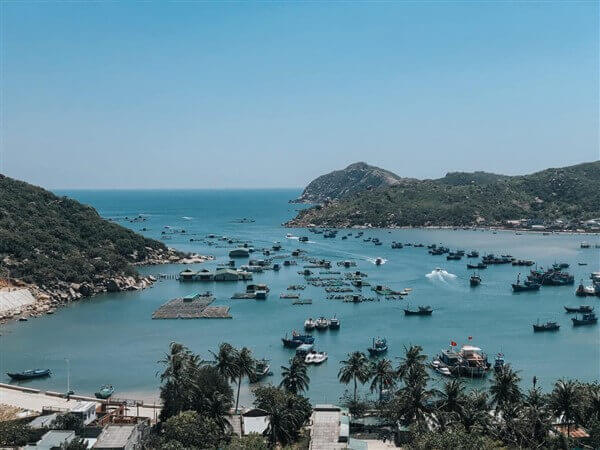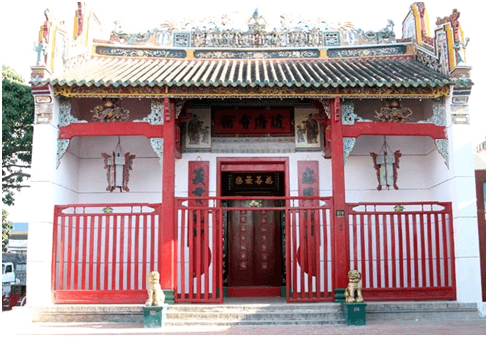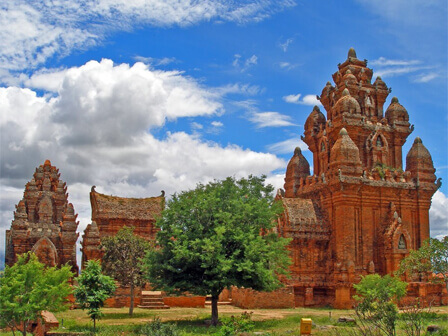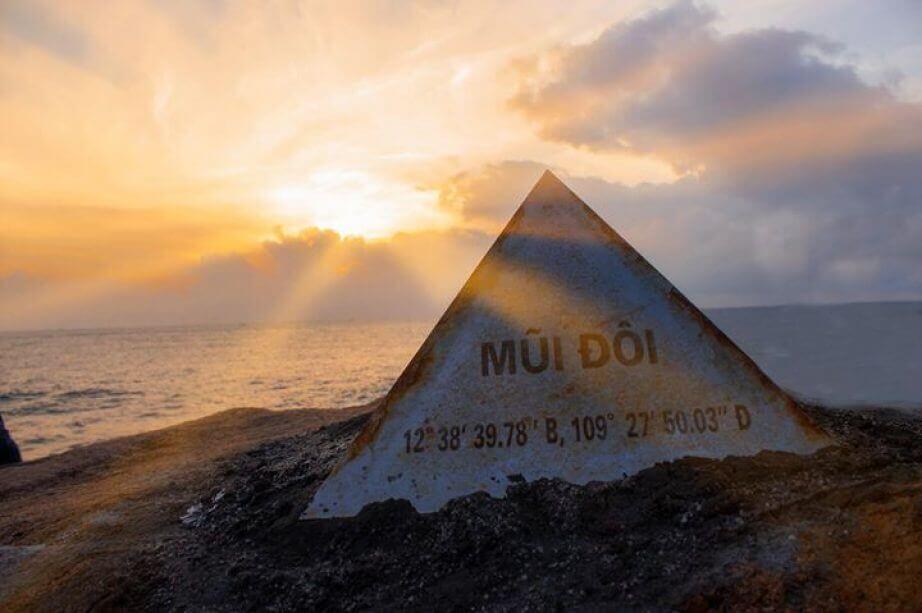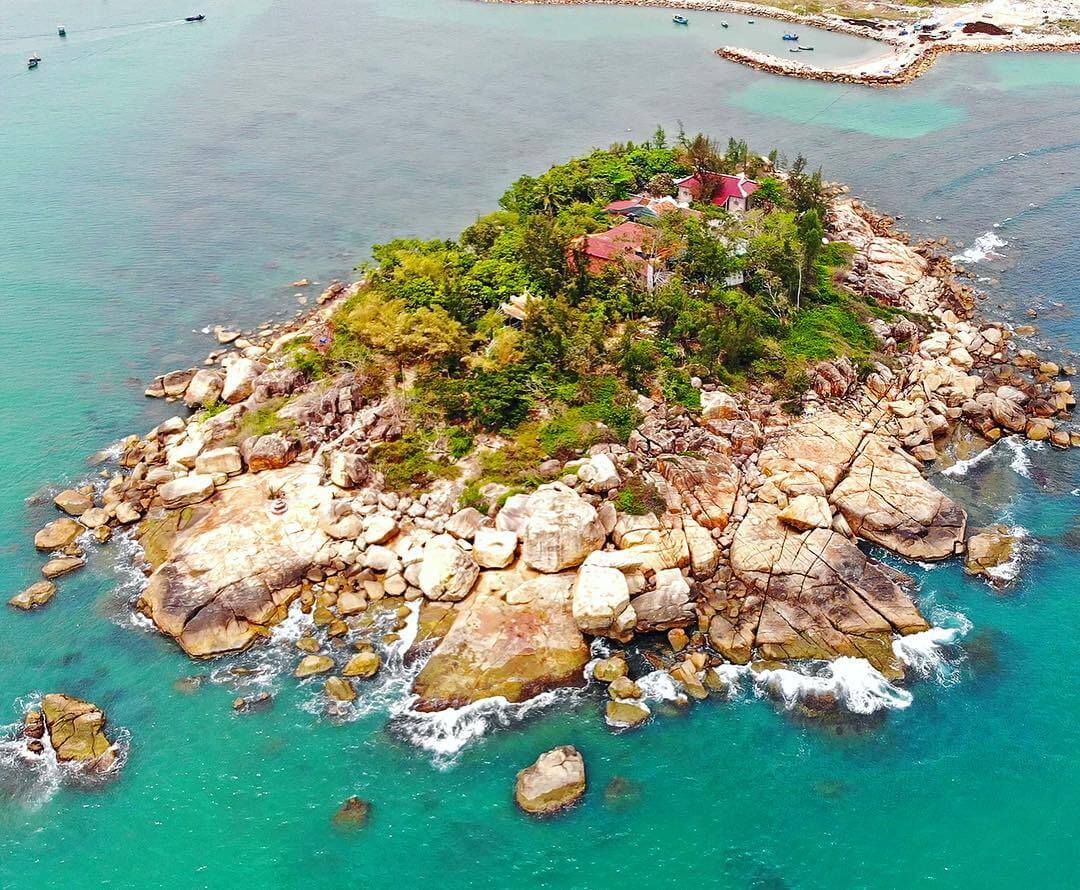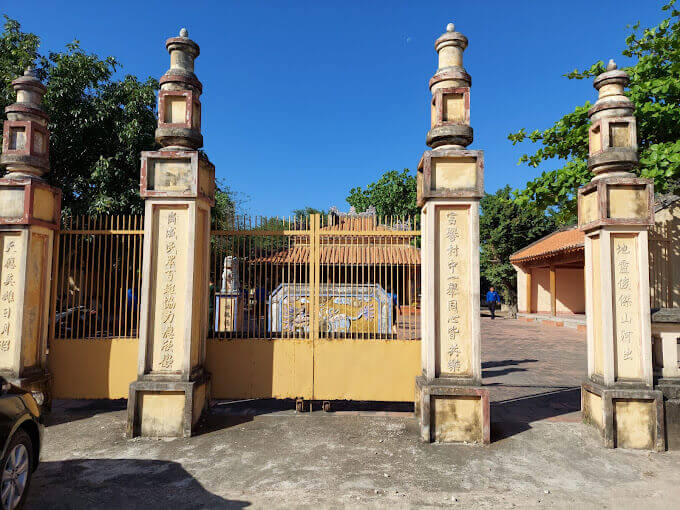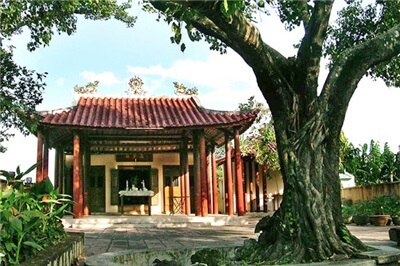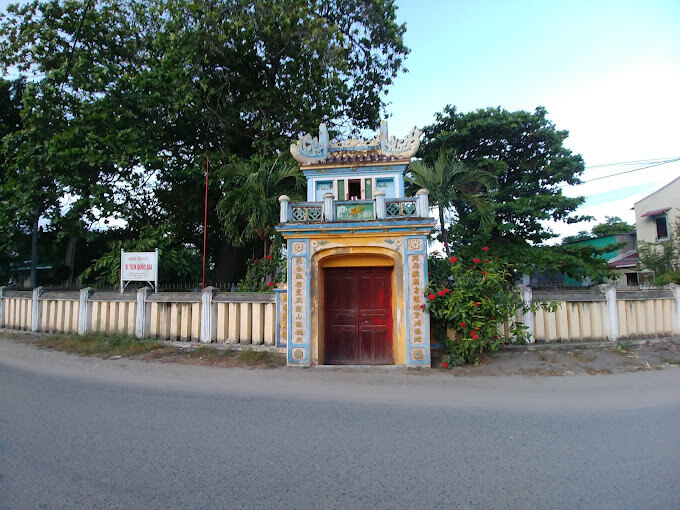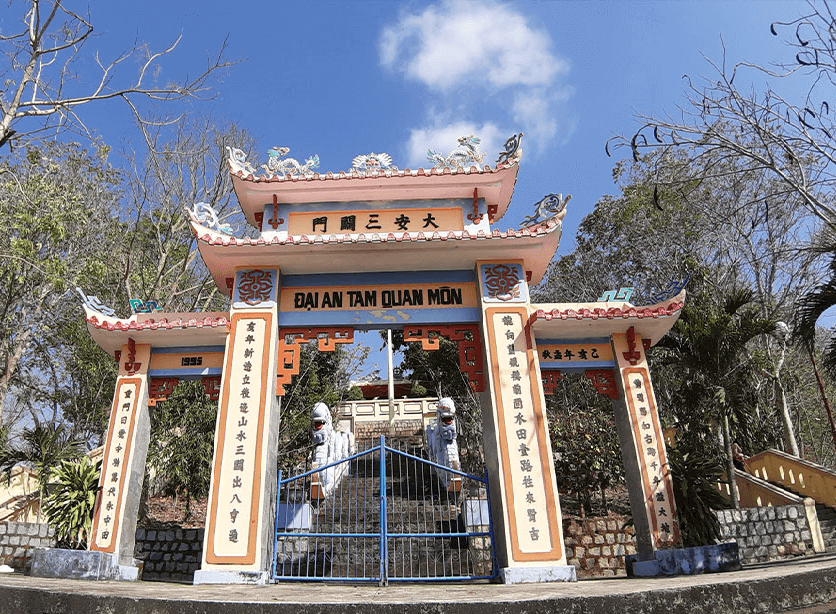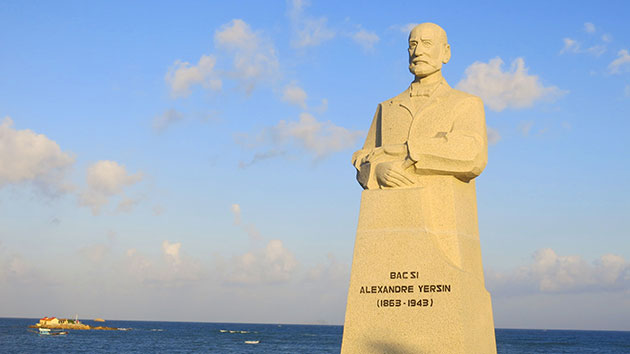Relic point Vietnam
Việt NamLandscapes of Vinh Hy Bay
Vinh Hy Bay is located in Vinh Hai commune, Ninh Hai district, Ninh Thuan province. Vinh Hy means the desire to trade busy, bustling with many opportunities, lucky, towards a peaceful, happy and peaceful life. Vinh Hy Bay is also known as Vung Cai and Vung Gang. Vinh Hy Bay is about 42km northeast of Phan Rang - Thap Cham city center. This place is one of the destinations that attracts a large number of tourists and was included in the project "Building and developing a key tourism route in Ninh Thuan province", including: Pottery village. Bau Truc, My Nghiep weaving, Po Klong Garai tower, Thai An vineyard and Vinh Hy Bay. Vinh Hy Bay is a landmark that has been established by the Vietnam Record Organization in the top 10 most beautiful bays of Vietnam, in the overall planning of Vietnam's tourism development to 2020 and a vision to 2030. Vinh Hy pier goes in the left direction for about 5 minutes of sea, will first meet the inner and outside toad beach. This is a rocky beach that floating the water with the shape of a toad is "God". Next is the nose of the whale, also known as the tip of the Tay Sa, is the image of a giant whale protruding up the water, towards the sea as calming and protecting silently to bring peace to the The sea and land of Vinh Hy. This is the work of nature, the creation of mountains and sea, but for the people of Vinh Hy, it also has deep spiritual meaning. Because whales or fish are ordained by the Nguyen Dynasty with the title of Nam Hai Cu Cu Tribe Ngoc Lan Ton Than and the people here always respect his fish because of the efforts to protect, protect and bring luck luck for bumper crops. Next is Hon Tai, then the stone mast, Hon Quy is created by nature on the waters of Vinh Hy. Hon Lion) - are beautiful beaches, natural products bestowed on Vinh Hy Bay, with fine white sand, blue sea is the ideal stop for tourists when visiting the bay. Next is a robotic stone location with horizontal and vertical stones on top of each other to create a robot shape. The next destination on the bay is the Yen cave, the place to reside for bird's nest and is also the unique highlight of Vinh Hy Bay. The cave is made up of diverse stones in size, rich in morphology, both rugged and no less vivid, creating a colorful picture of birth is mixed in an improvised way. Next is Ganh Black, Bai Ham, Bai Kinh, Mui Da Wall ... The image of the mountain cliffs is reaching out to the sea. The climate here is tropical monsoon, the average annual temperature is about 27 degrees Celsius, the average humidity of 71%, the bay concentrates many species of fish, shrimp, age spots, ... and especially with many coral reefs Stunning. Located right next to the bay about 10m, there is 1 architectural work of the Nam Hai Lang village of Vinh Hy village, built with solid reinforced cement. The mausoleum has an area of 1,016m2, the length of 36m mausoleum, 28m wide including the works: the gate of the mausoleum, the room, the flagpole, the martial arts ground, the Chief Bai's house, the Tien Hien house, the warehouse, the kitchen, the Thuy Long temple. With the aesthetic values mentioned above, the Ministry of Culture, Sports and Tourism ranked Vinh Hy Bay as a national landscape in Decision No. 44/Decision -The Culture and Sports Culture on 07 /01/2020. Source of cultural heritage.
Khanh Hoa 2833 view
Ong Pagoda
Ong Pagoda has a construction area of 400 square meters located in Kinh Dinh ward, Phan Rang city- Thap Cham. This is the basis for worshiping the holy virtue of the Chinese community with a unique architecture that reflects the peak of the temple building skills of local residents in the late nineteenth century. Ong Pagoda was granted a national monument by the Ministry of Culture, Sports and Tourism on April 14, 2011. Mr. Hang Thai Chau, Head of the Monuments Management Board of Ong Pagoda, said that according to the beer signed at the temple, showing the Chinese people from the provinces of Fujian and Trieu Chau immigrated to Ninh Thuan in the early nineteenth century. In 1831, the people set up a temple to worship the Guan Gong that showed the loyalty to encourage the united, honest and filial Chinese community. The small construction temple is located along the North -South natural road, which is very convenient for traveling to the Chinese community. In 1909, Ong Pagoda was officially restored and built with a large scale of the religious culture of the Chinese people to this day. The pagoda he built in a three -shaped word consists of three spaces: the holy holy world; The temple has a large yard for people to come to worship; The restaurant is a place to exchange for the Chinese community. The system of columns, thunderstorms, and great trusses are carved exquisitely, reflecting the peak in the architectural art of the temple in the late nineteenth century. On the roof of the pagoda is decorated with the image of Mesopotamia; The roofs are carved unicorn, phoenix, flowers lively lines, bright colors. Ong Pagoda also stores many ancient worshiping items with valuable art in bronze, ceramics and worship. And four ordinations of Thieu Tri, Tu Duc and Dong Khanh kings. Ong Pagoda took place annual sacrifices on January 13 of the lunar calendar to worship "Dao Vien"; On the 13th of the lunar month of Quan Binh; June 24, Mr. Quan Thanh. Especially on New Year's Eve, the local Chinese came to burn incense to pray for the nation of the people, the family prosperous in the new year. Ong Pagoda has a beautiful architecture in the center of the city. Phan Rang-Thap Cham is a tourist destination. Source of the portal of Phan Rang - Thap Cham City, Ninh Thuan Province
Khanh Hoa 2755 view
Klong Garai
Klong Garai Po Tower (also known as Klong Giarai Po Tower, Klaung Garai Po Tower, Poklaun Garai, Buu Son Tower), Do Vinh Ward, Phan Rang - Thap Cham City, Ninh Thuan Province. According to the legend of the Cham people, the Klaung Garai tower was made (King Jaya Simhavarman III) for construction to worship Po Klaung Garai - the king has many merits for the Cham people in fighting against foreign invaders, opening ditches, embankment The dam makes the field lush ... Therefore, he has been considered by the Cham people as a king - ultimate god (Shiva) and worshiped in the Klong Garai Po Tower. Po Klong Garai Tower is associated with the history of formation and development of Panduranga - the southernmost land of the ancient Champa kingdom, now in Ninh Thuan and Binh Thuan provinces. Based on beer, architectural style, decorative art, the same artifacts associated with the monument and some other documents ..., it can be believed that, at the current temple position, there was a temple of Siva worshiping tower ( ?), Built in the 11th century, then transformed into the worshiping tower of Po Klong Garai (combined with Siva). That is, Klong Garai Po Tower can now be built on the foundation or renovated and embellished on the basis of an old tower around the end of the thirteenth century - the early fourteenth century. This is a very interesting issue, which needs to continue researching and deciphering. However, with the main object is the Klong Garai Po Tower associated with the function of worshiping Po Klong Garai, we temporarily determined, the current tower dating back around the end of the thirteenth century - the early fourth century. The monument is located on the land with a total area of 86,969.3m2 (protection area I: 1,571.5m2, protection area: II 8,5397.8m2). Within the current relics, in addition to the items of the yard, garden, fence, internal roads, gates (entrance to the relics and the eastern gate), the work complex for tourism - culture, auxiliary architecture Support, temple, architectural ruins ..., and 3 original architecture is relatively complete, including the central tower (Kalan), the gate tower (Gopura) and the house tower. 1.The central (Kalan): is the main worship tower, built on the center of the hill, the largest scale, over 20m high, square pitcher, size 10.5 x 10, 5 meters. 2. Gate tower (Gopura): The tower has a square ground and is a miniature image of the main tower, about 10m high, located in the east of the main tower, opening two doors in the direction worship tower. 3. The tower has a rectangular surface, East -West rotating, 8m long, 4m wide, nearly 10m high. The heart of the tower is divided into two rooms, opened three doors, two doors connected along the North -South axis and one door turned to the east. At the relic, many cultural, religious and beliefs of the community and cross -sights take place, but highlighting and attracting special attention, the Kate - New Year's Festival of the Cham people according to Brahmanism, with many typical ceremonies and performances of the Cham people. No document has not been confirmed, the Kate/Kate festival of the Cham people in our country appeared, but only knew that this ceremony was often followed by the Cham people in Brahmanism in 2 provinces of Ninh Thuan, Binh Thuan. Organized annually on June 30, July 1 to July 10 according to the Cham calendar, corresponding to the period of September, October or November (solar calendar), with the first day on temples - tower ; The second day in the common house of the village; The third day at home; From Wednesday to the end of July 10, the Cham calendar is usually for households. With typical special values, Po Klong Garai Tower Architecture Architecture (Phan Rang - Thap Cham City, Ninh Thuan Province) is ranked as the Prime Minister as a special national monument (in the decision No. 2499/Decision -The General dated December 22, 2016) ./. Source of cultural heritage.
Khanh Hoa 2847 view
Double Mui - Hon Doan (Hon Dau)
The famous landscape of Mui Doi - Hon Doan (Hon Dau) in Hon Gom peninsula, in Van Thanh commune, Van Ninh district, where the first landing welcoming on the mainland of the country. Mui Doi - Hon Doi (Hon Dau) has two lands protruding into the sea, the farthest nose lies in the coordinates of about 109028’0 "Eastern menstrual period and 12039’0" North latitude. Local people often call it Mui Doi and about 500 meters away, there is a small island of about 20,000 m2 is Hon Dau. Mui Doi - Hon Dau place is known by Khanh Hoa people more on the occasion of Nha Trang Sea Festival in 2005, when together with Nha Trang Bay, the Ministry of Culture and Information (now the Ministry of Culture - Sports and Tourism) ranked national landscapes on March 25, 2005. Thanks to the geological structure, the southern mountains of Truong Son reached out to the East Sea with seawater covered by the sea, so Khanh Hoa waters appeared many islands, large and small, forming many lagoons and bays. Khanh Hoa coast is mostly cliffs accounting for 2/3, the rest is fine sand coast. Therefore, it is the waves from the East Sea that has been invasive, eroding rocky mountains and continental shelf, giving Khanh Hoa coastal area many rocky cliffs, Ganh Da very majestic, impressive and beautiful beaches Beautiful, full of poetic. Among them, the beautiful scenery of Hon Gom peninsula, with a national landscape Mui Doi - Hon Doan (Hon Dau) is a typical. Standing here, we can see boats back and forth on international waters. If you have the opportunity to go to Mui Doi - Hon Doan (Hon Dau), stay overnight to wait for the dawn on the vast East Sea to feel the full beauty of this place. The scenery here has a pristine, fresh natural environment, there is no place like no human footprints. The sky is a vast blue sky. The naked eye can be seen at a depth of the sea tens of meters. Slowered, a few fishing boats along the island and the corners of the sea add to the wild and charming beauty of a island waters. Source of the Ministry of Culture, Sports and Tourism.
Khanh Hoa 2771 view
Hon Chong - Hon Do
Hon Chong - Hon Do scenic spot is located on the banks of Nha Trang Bay, belonging to Vinh Phuoc and Vinh Tho wards, Nha Trang city. The landscape includes: Hon Chong, Hon Do, and Nha Trang Bay. In 1998, the landscape was ranked national. Hon Chong - Hon Do scenic is formed by the creation of nature. Those are large and small rocks stacked into multiple layers stretching from the foot of La San hill to the East Sea to create an impressive layout in the natural scenery of Nha Trang Bay. There creating interesting images and beautiful and airy natural beaches. The northern stone group is called Hon Chong and a small stone group, lower in the south called Hon Wife. Creator cleverly arranged the stone beach protruding into amazing images such as "Heaven Gate", "Stone arms", "Sea kiss", "Tien Ong" ... have formed folk legends Roll, attractive and humanistic. Legend of "Fisheries and Husbands": There is a poor couple living by coastal fishing. The couple often go out to catch shrimp and fish to feed their families. One day, the big breeze drifted their boats here. Large stones and big waves engulf the small boat. The boat broke down and swept his wife away, the husband rushed to save his wife. But every time he pulled his wife close to the shore, the large waves were stamped into the rock and pushed the couple away. The husband tried to save his wife, one hand clinging to the cliff, one hand holding the beloved wife. But the intense large waves engulfed the fishermen and they died together. Today, at Hon Chong scenic, there is still a large rock imprinted with five fingers' hands of the husband, demonstrating the passionate, profound and loyal couple. The legend of the giant giant Du Son Thuy: In the old days in the world full of fragrant flowers, strange and poetic scenery, so the fairies often went to the naked naked. The fairies play chess, female fairies playing, the giants go to sightseeing ... Every occasion of the earth, the fairies are freely joking and enjoying, taking off the Siamese soaked in the cool spring. Or expose himself to the blue coast of the murmur ... One day a giant was looking for beautiful, strange scenery, accidentally he saw the fairies soaked in the clear blue sea. Enjoying, he walked down and almost fell. While playing with, the giant clinging to the rock, making the mountain rocks, scattered everywhere, a stone with his fingerprints rolling out to stay on the pile of the island, and the stone with his footprints lying down on the stream Tien (Dien Khanh). Today, the stone imprinted with the fingerprints remains and becomes the evidence of nature about the giant giant bewildered to see the fairies. And the beach where the fairies used to be folk was called Co Tien beach not far from Hon Chong. About 100m from Hon Chong to the south is Hon Toi, small and located in a more discreet position. From a distance, the wife of the wife is like a faithful wife hugging her child to sit and petrified, waiting for her husband to go out. There are also people who imagine that the cuddling scene of the faithful wife. From Hon Wife, looking to Hon Chong looks like a new chubby chicken lying, head towards the mainland. About 300m from Hon Chong to the southeast is Hon Do. The name of the Red Hon is derived from the phenomenon of stones with redness every time the sun shines down here. On the small island still preserves the natural and romantic natural scenery. Those are the red color of the scenes of ti golf, the white color of porcelain flowers by the large cliffs. In the future this will be an attractive destination for you when coming to Nha Trang, walking on a small island just a few hundred meters from the mainland. Standing in Hon Chong - Hon Do watching Co Tien mountain is located in the north, on the banks of Nha Trang Bay is an interesting thing when you come to Tang - Khanh Hoa. At sunset and when the yellow sunshine hugged the mountain of Co Tien, the mountain made the mountain more brilliant and attractive. No need to imagine many customers can also see the image of the young girl full of vitality lying on Nha Trang Bay. The hair went smoothly to the sea, the chubby face, the full chest and the small waist leaned by the beach. Far away in front of Hon Chong is Hon Rua and Yen Island as money and accents for visitors to see Nha Trang Bay. The southeast is Hon Tre Island like the wall keeping Nha Trang Bay always quiet. On the island is Vinpearl Land tourist area - Hon Ngoc Viet. Source of the Ministry of Culture, Sports and Tourism.
Khanh Hoa 2546 view
Phu Cang communal house
Phu Cang communal house is the name associated with the name of Phu Cang village (Phu Cang village) in Van Phu commune, Van Ninh district, Khanh Hoa province. The communal house was built here by Vietnamese residents in the late seventeenth century and early eighteenth century to worship the village tutelary god, worshiping Thien Y Thanh Mau, Tien Hien, Hau Hien (those who have publicly reclaim the land. belt, people, establishing hamlets, creating villages ...) and worshiping martyrs who were the people of the village sacrificed in the two wars against the French colonialists and the American imperialists. The communal house was built on a high position, wide at the beginning of the village. The communal house is located in a fairly large campus, on a high area, an area of about 1,700m2, turning to the northeast. From the outside, the monument includes architectural works: Nghi Mon (Gate), Phong Phong, Dai Dinh, Dong Dynasty, Western Dynasty. Dai Dinh was built in a traditional structure with a wooden frame with 04 large wooden columns in the middle that looks very superficial, firmly supporting the roof system with a traditional architecture of Khanh Hoa. Along with the yin and yang tile roof, the door system is in the style of "upstream" and the mascot images: Mesopotamia of the Chau Chau, the nghe, the bat on the top Country. Those are the unique ancient architectural values of the Vietnamese communal house. In addition to the architectural element, it has been reserved quite complete for hundreds of years of many variables, the communal house also has a hallmark of revolutionary history through the periods of resistance against the French colonialists and American imperialism invading comb. In particular, this is one of the typical relics of the early August Revolution in 1945 in Khanh Hoa province in general and Van Ninh district in particular. In 1885, in response to Can Vuong against the French of Ham Nghi King, the Can Vuong movement in Khanh Hoa was stood up by the patriots and writers to gather the masses against the French. The leader of the movement is Binh Tay General Trinh Phong, and Deputy General - the Northern Governor of the Road. In Van Ninh and Ninh Hoa with the command of the Governor of Tran Duong, he attacked France many horrific phen and Dinh Phu Cang was the gathering place for the army to practice to fight the French from Deo Ca. Because the French colonialists were equipped with state -of -the -art weapons, and the insurgents mainly use rudimentary weapons, the force of the army was weakened and was suppressed by the French colonialists, the insurgents had to retreat. In 1886, the French did not catch Tran Duong, so he tried to suppress the people and his family members, Tran Duong went to the goods so that the French colonialists did not suppress the people. They killed him and beheaded the market to threaten the patriotic movement. After he died, the people brought his card to worship at Phu Cang Dinh with a respectful gratitude to the local hero. In 1930, the Communist Party of Vietnam was born leading the patriotic revolutionary movement of our people. In 1936, a number of Communist Party members were operating in their homeland, including Mr. Mai Duong, gathering party members in Phu Cang communal house to establish the first Party cell in Van Ninh district. From here, Phu Cang communal house is the basis of the Party Committee of Van Ninh district during the resistance war against the French until the national independence. In 1945, in preparation for the uprising to win the government to the people, the Viet Minh organization here gathered young people to practice at night at the yard, some guarded and alarmed people when France patrol . Also at the communal house is the venue for meeting and studying 10 policies of Viet Minh's Front, thereby enlightenment to the people about revolutionary ideology, patriotism, love for the homeland and the responsibility of the entire people to fight the French. national liberation. Since then, the spirit of the revolutionary movement has increased. When the opportunity was ripe, on August 14, 1945, the Viet Minh Front in Van Ninh gathered the people of Van Ninh to return to Phu Cang communal house, using the drum of the communal house to make a signal of the people who launched the most people to stand up Gain power. In the period of 1945 - 1954, Phu Cang communal house was still a training place for self -defense and local guerrilla, strengthening the front of Nha Trang - Khanh Hoa 101 day and night against the French (October 23, 1945 - February 2 /1946) and supplement forces to the 365 unit of the inter -region. This force has participated in brave battle to create a glorious battle, kill tanks and armored vehicles of French in Co Ma pass. During the resistance war against the US to save the country, Phu Cang communal house was still a place associated with the local revolution. It is the place to raise revolutionary cadres, receive wounded soldiers of the Lunar New Year battle in 1968. In the years 1971 - 1972, Phu Cang communal house was the revolutionary base of comrades at the Geography base Base Ban Ban network (Ninh Hoa - Van Ninh), or from Van Ninh to Co Ma Pass to Phu Yen. With the revolutionary struggle traditions of the local people associated with the communal house, especially the place to launch the local people standing up to uprooting the authorities to win the people in the earliest people in Khanh Hoa, In 1998, the Ministry of Culture and Information (now the Ministry of Culture, Sports and Tourism) ranked Phu Cang Dinh Dinh as a historical - national cultural relic. Source of the Ministry of Culture, Sports and Tourism.
Khanh Hoa 2740 view
Trinh Phong temple
Trinh Phong was born in Phu Vinh village, Xuong Ha, Vinh Xuong district (now Phu Vinh village, Vinh Thanh commune, Nha Trang city). As a child, he was a smart, good study, passed a bachelor's degree in Vo (1864) and was held in the Nguyen Nam Dynasty by the Nguyen Dynasty in Quang Nam. Witnessing the miserable people, the court divided the sects under the invasion of the French colonialists, he came from the mandarins, returned to his homeland to wait for the opportunity to chase the invaders. Responding to the call of King Ham Nghi through "Can Vuong", the uprising "Binh Tay to save the National Union" led by Trinh Phong in 1885 reclaimed Dien Khanh citadel and owned the majority of Khanh Hoa province. In 1886, before the enemy's strength, the Can Vuong movement in Khanh Hoa was extinguished but the spirit of heroic and indomitable fighting was left in the hearts of the local people a particularly deep affection. Trinh Phong and two other leaders, Tran Duong and Nguyen Khanh were worshiped as "Khanh Hoa Tam Kiet". In the photo, the statue of Trinh Phong was placed in the middle of the worship in the temple. Trinh Phong Temple relics have a total area of more than 639 m2, located on the side of 23/10, surrounded by many houses, just below the canopy of double oil tree over 350 years old. The temple was built in 1886, associated with the story handed down in folk. The story said that when the Binh Tay General Trinh Phong lost his battle, the enemy washead him and brought it back to Dien Khanh to Thi Uy. After that, his level was buried by his relatives, but was monitored by the enemy, hanging a cloth bag holding his head on the dust next to the double oil tree. The next day, the locals discovered and brought their heads to burial and worshiped but did not know who the unfortunate was. It was not until a man who "went to the field" to claim to be Trinh Phong was murdered by the enemy, his head, buried by the people, created a worship, now please thank you. Since then, small Am is called Trinh Phong temple or Cay Dau Temple. After that, Trinh Phong Temple was given the 13th Thai King (1901) to the "Great Germany", then in the 9th King of Khai Dinh (1924), he continued to confer his ordination with the beauty " Bao Trung Hung Linh Pho is the main ", remembering the hero because the country forgot. The temple is built in the architectural style of a two -wing space, three doors are designed in the upper style, the wooden frame structure has the characteristic of traditional monuments in Khanh Hoa. The main hall hung a wooden diaphragm that engraved with Han Nom character "Van An Temple". The door system is designed in the upstream style. In the middle of Bai Duong, a simple wooden altar but showing ancient and solemn. Over time, the temple has passed many times to be renovated and embellished. Four square wooden columns support the roof of the main hall, on the body of the column carved two pairs of couplets in Han Nom characters and painted in the golden lacquer, above the carved pattern of flowers and leaves. Inside the main hall hung two pairs of sentences to praise Trinh Phong's merit. Between the main hall placed the Council's altar, the two sides placed a pair of fabric parasols, above the altar hanging a shock. Adjacent to the wall behind is a wooden church that is meticulously carved and engraved with the "god". And the double oil tree is about 30m high, 4-5 people hugging and standing next to the side protects Trinh Phong temple through many ups and downs of history. According to the seniors, no one knows how old the oil tree is, but according to the record, Lord Nguyen Phuc Tan let Cai Co Hung Ngoc almost reclaim the forest and expand the border in 1653 to see the huge double oil tree beyond surpassing Outstanding between the old forest, the Co -ordered the order not to cut down to create shade. In 2016, double oil trees were recognized as a Vietnamese heritage tree. Trinh Phong temple was recognized by the Ministry of Culture, Sports and Tourism as a national historical monument in 1991. Source of the Ministry of Culture, Sports and Tourism.
Khanh Hoa 2972 view
Dinh Tan Loc
Tan Loc Communal House is located in Quarter 4, Tan Tai Ward, Phan Rang - Thap Cham City, Ninh Thuan Province. The communal house was built at the beginning of the village. According to the village elders, in the 11th year of Minh Mang, after Mr. Phan Van Nghi applied to establish Tan Loc village in Kinh Dinh, Ninh Thuan district, Tan Loc communal house at that time was called Dinh Dinh Thuy, and was newly built. at the end of the village using simple bamboo stick materials. In the year of Giap Dan (1853) under the reign of King Tu Duc, Dinh Thuy Communal House was moved to its present location. The communal house worships the Thanh Hoang God, Thien Y A Na and Chief Eunuch Bach Ma. According to the customs left by the ancestors, every year Tan Loc village organizes a grand ceremony at the village communal house in the second month of the lunar calendar and a traditional middle ceremony in the eighth month of the lunar calendar. Each sacrifice is divided into three parts, with very solemn rituals, from the Opening ceremony, to the taboo ceremony of the Ancient Sages and the Sacrifice ceremony at the Main Hall. Tan Loc communal house, Tan Tai ward, has been recognized by the Ministry of Culture and Information as a historical, cultural, architectural and artistic relic. Tan Loc Communal House was built on a land area of 1,950 square meters, surrounded by a fence. The front of the communal house faces the Dinh River, the back side looks into the distance with Ca Du mountain as a strong backrest. Tan Loc Communal House is an architectural complex including: from the outside are the ceremonial gate, screen, brick yard, about 15m away is the main hall, connecting the main hall with Kieu's house is a small yard that the elders often call the temple. Thien Tinh (sky well). Adjacent to Kieu's house is Tien Hien's house. On both sides of the main hall are the East and West houses, in front of the East and West houses are two small temples, the East temple worships the Five Elements, the West temple worships the Earth God, and on the two sides of Kieu house are two Tru houses. (kitchen) but only one room in the east remains, while the one in the west is ruined. In the East, between the East house and the Tru house, there is a small gate (also called the East gate) used to go to the well to get water. Tan Loc Communal House is a valuable architectural work and wooden sculpture. Architecturally, the communal house is a complex of many four-pillar houses assembled together. The presence of pierced and missing trusses makes the area of the communal house expand to the surrounding area. Decorative themes in the communal house are quite diverse, most of the classical motifs are used and have a profound philosophical nature such as: "Four Spirits": Dragon symbolizes power, Lan symbolizes the desire for Thai Binh, Quy not only symbolizes endurance and long life, it is also conceived as a union in the relationship between heaven and earth. Mother, Phung represents the eternal desire of the Vietnamese people in their relationship with the gods. With the eight treasures theme, there is the Sun Flower (heaven) symbolizing the sacred place where the gods reside. The sword represents the power of martial artists to eliminate evil and demons. Fan figs to eliminate evil spirits. The altar represents the nobility of the Taoist. The wine gourd symbolizes Ly Thiet Quai's search for "forgetfulness" to escape the evil bonds of life and the Nhu Y stick represents power... Over the past 100 years, due to the impact of nature, Dinh has built through many renovations. During those renovations, due to limited awareness, some architecture such as the East house and West house were completely renewed on the old foundation, but basically the main hall and the Tien Hien house still retained the original elements. so it still does not lose the majestic, ancient appearance of the communal house. Source: Ninh Thuan Tourism Promotion Information Center
Khanh Hoa 4938 view
Am God
Am Chua is located on Dai An mountain, also known as Qua Son (Qua Lanh, Chua mountain, Cam mountain), the most common name Dai An in the past. Nui Chua is a mountain, 284 meters high. Am Chua is located halfway up the mountain, 80 meters above sea level, in Dai Dien Trung village, Dien Dien commune, Dien Khanh district, Khanh Hoa province. Up to now, there are no documents determining the specific time that Am Chua was built; But according to the story of local elders, Am Chua initially was a small hermitage located next to Dai An mountain pagoda on Hoa Son mountain and after many restorations, the hermitage became a place to worship Thien Y Thanh. The model is as spacious as today. Although the small pagoda named Dai An no longer exists, the blend of Mother Goddess worship and Buddhist rituals is still intact and is a typical cultural feature at Am Chua. The architectural system of worship at Am Chua has many similarities with the architecture of communal houses in Khanh Hoa. The worship structure has a coordination of worship and sacrifices that is similar to religious architectural works in the province and this is a religious feature of Khanh Hoa people. Architectural works at Am Chua include: Three gates, Mr. and Mrs. Tieu's tombs, inscriptions, Son Lam temple, Ngu Hanh temple, main hall. The main hall was restored for the third time in the year of the Dog (1958), the 4th time in the year of the Dragon (1988), and a major restoration in the year of the Ox (2009) with a three-room architectural form. The God Temple is decorated with altars, pairs of opposing tureens, and diaphragms carved delicately and sharply. The first altar is an incense altar worshiping the deity of Lady Tieu. The sacred altar of Thien Y Thanh Mau is splendidly decorated and is the most concentrated point of the worship structure in the Main Hall; On both sides are shrines worshiping the Six Immortals and the Twelve Immortals. On the left of the altar to worship the Holy Mother is the altar to worship the Four Crown Princes and the Twelve Executives, also known as the altar to Uncle (Prince Tri - son of the Holy Mother); On the right is the altar worshiping the Six Immortals and the Twelve Immortals, also known as the altar for the Lady (Princess Quy - daughter of Thanh Mau). All altars in the main hall are made of precious wood, carved with delicate and unique patterns and motifs. The entire main hall has a truss-style roof structure, rows of main columns and military columns made from highly valuable precious wood. Am Chua still retains two titles bestowed by the Nguyen Dynasty kings. According to folk beliefs, March is the month of Via Ba, "August is the anniversary of father's death, March is the anniversary of mother's death". Am Chua Festival is from the 1st to the 3rd day of the third lunar month every year and takes place according to a traditional process: Moc Duc (statue bathing) ceremony, Tam Hien Luong ceremony, main sacrificial ceremony, Van Mau singing, offering Female officials, Hau Thuong worshiping ceremony, incense offering ceremony and shadow dance. Through legends and folk tales, worship shows the continuity of culture and beliefs. Am Chua has brought within itself the values of the two cultures of Cham and Vietnam. Although there are different imprints, it must be affirmed that the image of Thien Y A Na is a Vietnamese creation, originating from the image of Po Nagar of the Cham people and originating from the image embodying the mother. creation of all species. With its tangible and intangible cultural values, in 1999 Am Chua was ranked by the State as a National Historical-Cultural Monument. Source: Ho Chi Minh Communist Youth Union, Khanh Hoa province
Khanh Hoa 3740 view
Memorial area of Dr. Alexandre Yersin
The memorial historical relic of scientist Alexan Dr Yersin was ranked as a National Monument by the Ministry of Culture, Information, Sports and Tourism on September 28, 1990. The relic is a complex of individual, typical, outstanding locations, directly linked to the life and career of scientist Alexan Dr Yersin, including 3 locations, which are the library at the Pasteur Institute of Nha Trang ( Tran Phu Street, Xuong Huan Ward, Nha Trang City), Linh Son Pagoda, Alexan Dr Yersin's grave (Suoi Cat Commune, Cam Lam District). Dr. Alexan Dr Yersin was born on September 22, 1863 in Switzerland. At the age of 20, he graduated from the University of Paris (France). In 1886, he worked at the Pasteur Institute in Paris and collaborated with Dr. Roux to find toxins. leukemic bacteria. In 1890, he was granted French citizenship. After he achieved certain successes in the medical field, Yersin suddenly left the field of microbiology - living a life of sailor and explorer - starting another life lasting 50 years. In 1891, he resigned from Messageries and went to Indochina to work as a physician for the Messageries shipping company to fulfill his dream of exploring new horizons. In July 1891, he came to Nha Trang for the first time. In 1895, Yersin founded the Nha Trang Pasteur Institute and prepared serum to cure the plague. A year later, the epidemic relapsed in China. Yersin went to China again and saved many people from the dangerous disease that killed 50 million people in ancient times. By the end of 1899, he returned to Nha Trang and established the Pasteur Institute. For nearly 50 years of living alone in Nha Trang, he devoted his entire life to his scientific career, successfully researching the production of medicine to cure the plague on June 20, 1894. Because he lived relatively simply and was close to the people of Con village, he was very loved by everyone. After that, he spent about two years (1902-1903) going to Hanoi to open the Indochina Medical College and become the first principal there. In 1924, he held the position of Inspector General of the Pasteur Institutes in Indochina. In 1933, he became honorary director of the Pasteur Institute in Paris. On June 28, 1935, Yersin High School was inaugurated in Da Lat, Yersin returned to Da Lat for the last time before his death. For the rest of his life, Yersin only lived and worked at the Pasteur Institute of Nha Trang. When he was old, he went to the top of the mountain above Suoi Dau to build a wooden house, grow medicinal plants, and research malaria medicine. Until his final days, he left a will with the wish to be buried in Suoi Dau. He would like to donate all of his assets to the Pasteur Institute of Nha Trang. On March 1, 1943, he died, the funeral was held very simply, many people came to see him off, following each other from Nha Trang to Suoi Dau. According to the will, when he was buried, people placed him on his stomach with his head facing the sea so that he would forever embrace his homeland. His tomb was built in a rectangular shape of cement, painted blue, with the words Alexan dr Yersin (1863. 1943) written on the surface. Source: Nha Trang tourism information portal
Khanh Hoa 4509 view
